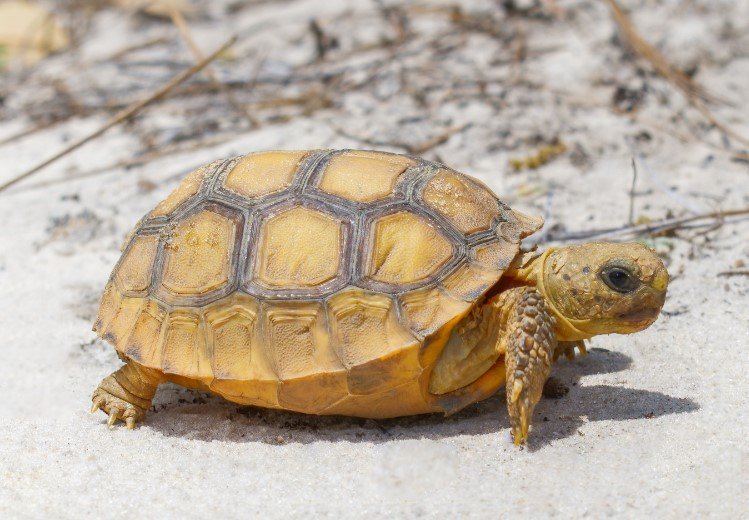Georgia wildlife officials announced a major win for conservation this week. The Georgia Gopher Tortoise Initiative has successfully protected 65 viable populations of the state’s official reptile, securing their future in the sandy soils of south Georgia.
This milestone, reached in late September 2025, involves a new easement on 1,210 acres south of Cordele that saves over 250 tortoises and their pineland homes. It caps a decade of teamwork to keep these gentle creatures off the federal endangered list.
What the Milestone Means for Georgia Wildlife
Conservation leaders celebrated the achievement as a big step forward. The initiative started in 2015 with a clear target to shield enough tortoise groups to ensure long term survival.
Now, with 65 populations under permanent protection, experts say the risk of federal listing has dropped. This helps avoid rules that could slow down building projects or farming in key areas.
The latest easement came from a family owned property in Turner and Crisp counties. Landowner Austin McKinney shared that his family has cared for the land for over a century, valuing its wildlife and forests.

Officials point out that this success shows how working together can protect species without heavy government rules. It sets an example for other states facing similar challenges.
How the Initiative Got Started
Back in 2015, only 36 of Georgia’s 125 known gopher tortoise populations had protection. Habitat loss from development and farming put the species at risk across the Coastal Plain.
The initiative formed with nearly 30 partners, including state agencies, nonprofits, businesses, and landowners. They aimed to conserve 100,000 acres of habitat and restore longleaf pine forests vital for tortoises.
Funding came from federal grants, foundations, and programs like the Georgia Outdoor Stewardship Program. The U.S. Defense Department also pitched in, seeing value in healthy ecosystems near military bases.
Over the years, efforts included buying land for wildlife areas and setting up easements on private property. Biologists even helped move tortoises safely from building sites.
This approach paid off in 2022 when federal officials decided not to list eastern gopher tortoises as endangered, thanks in part to these partnerships.
Why Gopher Tortoises Matter
Gopher tortoises are more than just Georgia’s state reptile. These dome shelled turtles dig deep burrows that serve as homes for over 300 other animals, making them a keystone species.
Their tunnels offer shelter to rare creatures like the eastern indigo snake and provide escape from fires and predators. Without them, entire ecosystems in the southeast could suffer.
Here are some key facts about these unique reptiles:
- They live up to 60 years in the wild and grow to about 10 inches long.
- Females lay 5 to 9 eggs each year, but hatchlings face high risks from predators.
- Populations need at least 250 adults to stay healthy and grow over time.
Habitat threats like urban sprawl and invasive plants have cut their numbers. But programs like head start initiatives at places such as the Warm Springs National Fish Hatchery raise young tortoises safely before release.
This conservation push ties into broader efforts, including Georgia’s updated State Wildlife Action Plan from 2025, now under federal review. It focuses on non game species and longleaf pine restoration.
Key Efforts and Partnerships Driving Success
Teamwork has been the backbone of this initiative. Partners range from the U.S. Fish and Wildlife Service to private foundations and local landowners.
Strategic surveys found unknown tortoise groups, while coordination with developers reduced harm to burrows. Acquisitions like the Ceylon and Alapaha River wildlife areas added protected lands.
A recent table of achievements shows the progress:
| Year | Protected Populations | Acres Conserved | Key Action |
|---|---|---|---|
| 2015 | 36 | 20,000 | Initiative launch with partners |
| 2020 | 50 | 60,000 | Major land acquisitions begin |
| 2025 | 65 | 100,000+ | Final easement near Cordele |
These steps not only save tortoises but also boost recreation and support species like quail and songbirds.
Economic benefits include avoiding costly regulations that could hit industries. Commissioner Walter Rabon noted this model could inspire future wildlife projects nationwide.
Looking Ahead for Tortoise Conservation
With the goal met, the focus shifts to ongoing care. Partners plan to monitor populations and restore more habitats amid climate change pressures like stronger storms.
Federal programs continue to offer easements for landowners in tortoise zones. This builds on 2025 updates to conservation plans, aiming for even more resilient ecosystems.
Experts warn that challenges remain, such as illegal poaching and habitat fragmentation. But the initiative’s success offers hope for other at risk species in the region.
Share your thoughts on this conservation win in the comments below, and spread the word by sharing this article with fellow nature lovers.
